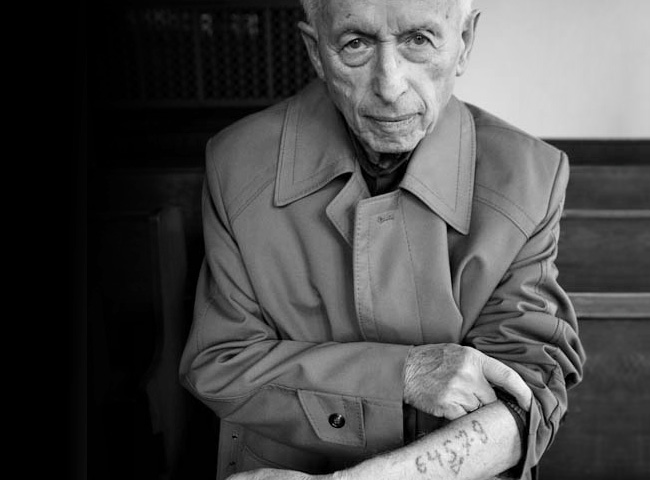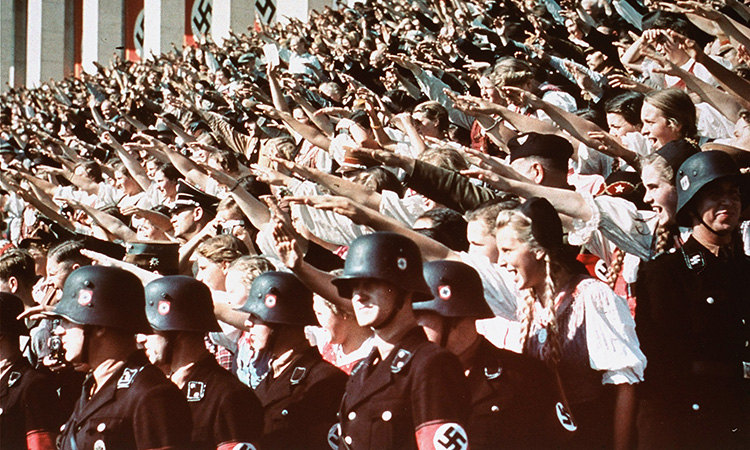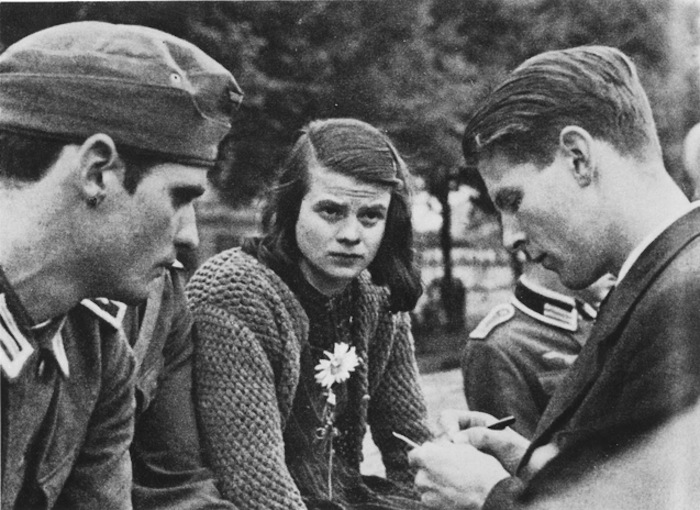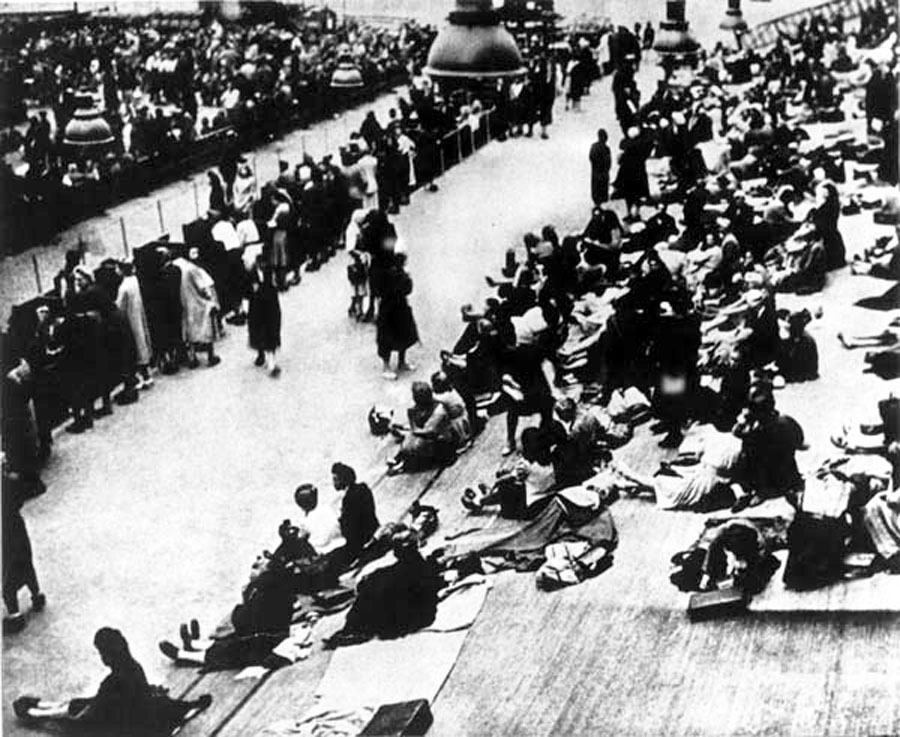Educator Tools

 Ask yourself:
Ask yourself:
- What motivated people living under the reign of Hitler to conform or dissent against antisemitic actions?
- Was there a clear divide between conformists and dissenters?
- Where does the role of a bystander fit into the discussion of conformists and dissenters?
Before in-depth examination of the Holocaust, it is important to understand some basic facts. The video interview is a good introduction to the 5W’s (When, Where, Who, What and Why) of the Holocaust. When studying genocide, we might ask ourselves how the world can let such horrendous events occur. This chapter will allow you to examine this question in more detail by using the Holocaust as a case study for discussing the role of conformists, dissenters, and bystanders. You will begin by brainstorming with classmates why people might decide to conform or dissent and will organize a list of historical identities under these two terms. You will then use primary sources from multiple perspectives to understand why historical characters thought and acted as they did, as well as learning the importance of avoiding generalizations. Afterwards, you will reflect on the role of a bystander and decide where this role fits within the previous discussion and within your own lives.
 Definitions
Definitions
Undesirables: Groups of people deemed unworthy and unwanted by the Nazi regime because they were an impediment to Hitler’s goal of creating a pure “Aryan race.” These groups included Jews, Roma and Sinti (known by the pejorative word “Gypsy”), people with disabilities, gays and lesbians, political enemies (especially communists), Christians who refused to follow Nazi racial policies (like Jehovah’s Witnesses), Slavic people (and their religious and political leaders especially), and the few Germans with African ancestry.
Dissenter: Someone who rejects, disagrees with, and/or acts in opposition to a policy.
Conformist: Someone who supports, agrees with, and/or acts in accordance with a policy.
Bystander: Someone who observes a situation but chooses not to become involved.
Hitler Youth: A youth organization in Nazi Germany that trained and educated boys (aged 10-18) to actively support the Nazi regime. Girls had their own League of German Girls (Bund Deutscher Mädel [BDM]).
The White Rose: A group of German university students who began a non-violent and anonymous graffiti and leaflet campaign against Hitler and the Nazi regime. Its leaders, Hans and Sophie Scholl, as well as Christoph Probst, were executed by guillotine four days after their arrest, on February 22, 1943.
Reserve Battalion 101: A death squad consisting of middle-aged and middle class German men who were assigned the task of carrying out the Final Solution in Jozefow, Poland.
Basic Facts
The Second World War (1939-1945) was not only characterized by territorial conquest, but also by the strong ideological and racist elements connected to it. The racial ideology was founded on pseudo-scientific racial theories and antisemitism driven by Adolf Hitler and his National Socialist Party. Antisemitism is hatred expressed toward Jews and is historically associated with hostility toward their religion and ethnicity in Christian Europe. However, Adolf Hitler gave antisemitism a new shape by adding a racist foundation to the hatred and, more importantly, he made antisemitism state policy in Germany and in the territories he occupied during WWII.
During the Second World War, countless physical acts of violence were perpetrated against Jews and other populations deemed “undesirable” by the Nazis. Jewish people were shot to death, underwent starvation, were poisoned in gas chambers, and burned in crematories. This mass murder or genocide of the Jewish people would come to be known as the Holocaust. Prior to the war, there were approximately 11 million European Jews and by the war’s end, approximately 6 million were killed.
When learning about the Holocaust we might ask ourselves how the world let such a horrendous event occur? The truth is the extent of the genocide was not known until years after the war and new evidence continues to be found today. This seems to contradict the quote in the Overview of this chapter: “Churchill had detailed knowledge of location and magnitude”. Regardless, you may still be wondering how this could have ever happened. In this chapter we will be examining the historical perspectives of different actors associated with the Holocaust and the roles they played as well as their attitudes towards the event.
Historical Perspectives
Taking the time to consider multiple historical perspectives helps inform our understanding of the past and provides us with insight to why certain events occurred as they did. It goes beyond identifying and empathizing with historical actors, to investigating the historical context that influenced the thoughts and actions of people at that time. However, we have to be careful not to make assumptions about the past using our own sets of values and beliefs, because our standards differ from those in other times and places in history. This being said, we can use historical evidence as an entry point to understanding the various political, social, economic, geographic, and emotional contexts that shaped the past and people’s perspectives. You will have the opportunity to use the following primary sources to understand different historical perspectives around the Holocaust and decide to what extent the world willingly let the event happen.
 Artifacts
Artifacts
Artifact 1 › Photograph of Hitler’s Youth Organization, dated 1938
“Indoctrinating Youth.” Nazi Youth 1938
Artifact 2 › Passages from a Popular Children’s Book used in German Schools, 1936
“The Lord God conceived the races:
Red Indians, Negroes, and Chinese,
And Jew, too, the rotten crew…
He gave them all a piece of earth
To work with the sweat of their brow.
But the Jew went on strike at once!
For the devil rode him from the first.
Cheating, not working, was his aim;
For lying, he got first prize”
“The Jew has always hated him!
Here is the Jew, as all can see,
Biggest ruffian in our country;
He thinks himself the greatest beau
And yet is the ugliest, you know!”
Source: Bauer, Elvira. Trust No Fox on his Green Heath and No Jew on His Oath. Nuremberg: Sturmer Verlag, 1936.
Permission granted by Randall Bytwerk
Artifact 3 › Memoirs from two German soldiers from the Reserve Police Battalion 101, a death squad hired to kill Jews in Jozefow, Poland during the summer of 1942.
“Those who did not want to or could not carry out the shooting of human beings with their own hands…remained by the arriving trucks and kept himself busy at arrival point. It could not be avoided that one or another of my comrades noticed that I was not going to the execution …they showered me with remarks such as ‘shithead’ and ‘weakling’ to express their disgust. I was not the only one who kept himself out of participating.”
“I then cocked my carbine and shot him through the back of the head [an elderly Jew]. Because I was already very upset from the cruel treatment of the Jews…parts of the skull flew…I had become so sick that I simply couldn’t [shoot; kill] anymore.”
Source: Browning, Christopher R. “Ordinary Men” in The Holocaust: Problems and Perspectives of Interpretations, edited by Donald L. Niewyk. Connecticut, Wadsworth Publishing, pp.76-90.
Artifact 4 › Photograph of three members of The White Rose Movement in Munich, Germany
The White Rose Movement
The White Rose was a youth movement active in Munich, Germany from June 1942 to February 1943.
Source: Jewish Virtual Library.
Artifact 5 › Passages from two of the leaflets that the White Rose anonymously distributed throughout Munich and surrounding German cities.
“It is certain that today every honest German is ashamed of his government. Who among us has any conception of the dimensions of shame that will befall us and our children when one day the veil has fallen from our eyes and the most horrible of crimes—crimes that infinitely outdistance every human measure—reach the light of day?”
First Leaflet, 1942
“Since the conquest of Poland three hundred thousand Jews have been murdered in this country in the most bestial way. Here we see the most frightful crime against human dignity, a crime that is unparalleled in the whole of history. For Jews, too, are human beings—no matter what position we take with respect to the Jewish question—and a crime of this dimension has been perpetrated against human beings.“
Second Leaflet, 1942
Source: Inge Scholl, The White Rose: Munich 1942-1943, Trans. Arthur R. Schultz. Connecticut: Wesleyan University Press, 1983, pp.73-80.
Artifact 6 › A Response from the United States Federal Government concerning the approaching S.S. St. Louis (Telegram sent June, 1939)
Those aboard the S.S. St. Louis must, “await their turns on the waiting list and qualify for and obtain immigration visas before they may be admissible into the United States.”
Artifact 7 › A Photograph captured at the Vel’d’Hiv Roundup, July 1942.
A Photograph captured at the Vel’d’Hiv Roundup, July 1942
4,045 Jewish adults and 4,115 Jewish children rounded up by French police in the bicycle stadium in Paris called Vel’ d’Hiv (V’élodrome d’Hiver), where they were held for four days before being transported to camps. Photo Credit: United States Holocaust Memorial Museum
Over the two days of July 16th -17th, 1942, French police forces participated in rounding up and killing Jews in Nazi occupied France. Many Jews lost their lives after being forced into this arena by French officers.
Source: French Culture Guide.
Artifact 8 › Quotes from residents living in Le Chambon-Sur-Lignon, a village in South Central France.
“As soon as the soldiers left, we would go into the forest and sing a song. When they heard that song, the Jews knew it was safe to come home.” (1941)
“We didn’t protect the Jews because we were moral or heroic people. We helped them because it was the human thing to do.” (1989)
Source: Differences into Opportunities. Harvard Business Press, 2006, p. 27; The Holocaust: Crimes, Heroes, Villains.
ACTION 1
Think
Mind-Webs
Historically, why do you think people living during the reign of Hitler conformed with or dissented against the acts of the Holocaust? Create a mapping of connected thoughts/decisions made demonstrating these linkages.
ACTION 2
Think
My connections to history
Take a moment to independently and carefully observe each of the above artifacts (1 through 5). What intrigued you about these artifacts? Did they remind you of personal stories and events? How are they important to our knowledge of the Holocaust?
ACTION 3
Discuss
Seeing the stories
Complete the following exercises with a partner:
- Compare Hitler’s Youth and the White Rose Movement (Artifacts 1 & 4). What are some similarities and differences between the two organizations? How do the images inform our perception of German youth and Germany in general during this time?
- Re-examine Artifact 2, how effective is a children’s book as a tool for propaganda? Typically, propaganda is used to target older age groups. Why would targeting children be significant—if it is?
- Does Artifact 5 provide us with a truthful representation of soldiers working for Nazi Germany? How useful are these quotes in helping us understand the perspectives of German soldiers?
- Evaluate whether each Artifact provides us with an example of a person or group conforming with or dissenting against the Holocaust? Explain your reasoning.
ACTION 4
Discuss
Using Artifacts 6 through 8, discuss 4 of the 5 the following questions with a partner.
- What are some of the possible risks people face when conforming? And when dissenting?
- To what extent do you think that societal systems and structures influenced the actions of its members?
- Explain whether or not Artifact 6 is an example of conforming to the Nazi regime? How do the actions of the French police in Artifact 7 compare?
- To what degree was the United States justified in delaying the Jewish refugees entry? Is it fair to allow unlimited entry to any refugee? Where and when should we draw the line?
- After completing the activities, do you think the world willingly let the Holocaust happen? Why? Be sure to justify your reasoning.
ACTION 5
Think
The Bystander
Read the following poem written by German Protestant pastor, Martin Niemoller, during the Nazi reign.
First they Came
First they came for the Socialists,
and I did not speak out—Because I was not a Socialist.
Then they came for the Trade Unionists,
and I did not speak out—Because I was not a Trade Unionist.
Then they came for the Jews,
and I did not speak out—Because I was not a Jew.
Then they came for me—and there was no one left to speak for me.
Permission: received by Sibylle Sarah Niemoeller von Sell
Source: The United States Holocaust Memorial Museum. First They Came.
Reflections:
- Independently, reflect on how this poem speaks to us about the role of a bystander.
- In your opinion, where does a bystander fit in our previous discussion of conformers and dissenters? Argue whether a bystander should be considered the former or the latter. Discuss your choice and reasoning with a partner.
ACTION 6
Think
Nazi Medical Experiments
During the Second World War, a number of German physicians conducted painful and often deadly experiments on thousands of prisoners without their permission. Considering the inhumane conditions, lack of consent, and questionable research standards, modern scientists overwhelmingly reject the use of results from experiments in the camps.
Nazi Medical Experiments
Spotlight on Mengele, the Angel of Death
Do
Read the article: Josef Mengele Angel of Death. Identify what Mengele did that prompted the nickname “Angel of Death”.
Discuss
A. Google and read the Hippocratic oath and discuss as a class, the moral imperatives of the Hippocratic Oath. How could Mengele and the other German doctors break their oath so easily, considering how important upholding one’s oath was to Germans of the era?
B. Is it ever morally acceptable for us to use the data acquired through immoral means such as that acquired by the Nazi doctors and scientists? Why or why not?
Do
Read the article about Eva Kor: Auschwitz Twin Experiments Survivor
Discuss
In pairs, discuss why Eva Kor’s principle of forgiveness of the Nazis is controversial. How might humanity be elevated if Eva Kor’s forgiveness principle were accepted and applied universally?
ACTION 7
Do
Holocaust Survivors in Canada
The Holocaust Survivor Memoirs Program by the Azrieli Foundation was established to collect, preserve and share the memoirs and diaries written by survivors of the Holocaust who came to Canada. These memoirs — published in both English and French — are distributed free of charge to educational institutions across Canada.
https://memoirs.azrielifoundation.org/education/educational-materials/
Re:Collection is an innovative digital resource that combines video interviews with memoir excerpts, photos and artifacts, and features interactive timelines and maps to place survivors’ stories in historical and geographic context.
http://memoirs.azrielifoundation.org/recollection
We cannot generalize about the experiences of Holocaust survivors. The experiences are as different as the individuals themselves. Watch 3 of the video interviews and write a piece comparing their individual perspectives.
Further reading
Bartoletti, Susan Campbell Hitler Youth: Growing up in Hitler’s Shadow, 2005
The chilling story of Germany’s powerful Hitler Youth groups.
Boas, Jacob We Are Witnesses: Five diaries of teenagers who died in the Holocaust, 2009 Each diary in this collection reveals the voice of one teenager struggling with terror and clinging to hope.
Krygier, Joseph G. & Victor Breitburg A Rage to Live: Surviving the Holocaust so Hitler should not win, 2012 A historical account of Victor Breitbureg, a Holocaust survivor, who chose to move forward in search of his family.
Lewis, Jon E. Voices from the Holocaust: First-hand accounts from the frontline of history, 2012
The history of the Holocaust from Hilter’s rise to power to the Nuremburg trials. The anthology provides eyewitness testimonies that tell the story from people who were there, and were witnesses to both sides of the horror.
Wiesel, Elie Night, 2006
Originally published in 1960, this new translation provides an autobiographical account of Wiesel’s survival as a teenager in Nazi death camps. The author shares memories of loss, guilt, death and faith at having survived the horror of the genocide campaign that consumed his family. Titles in the trilogy include Night, Dawn, Day.
Every effort has been made to gain permission from copyright holders to reproduce borrowed material. The publishers apologize for any errors and will be pleased to rectify them in subsequent reprints and website programming.
Educator Tools






